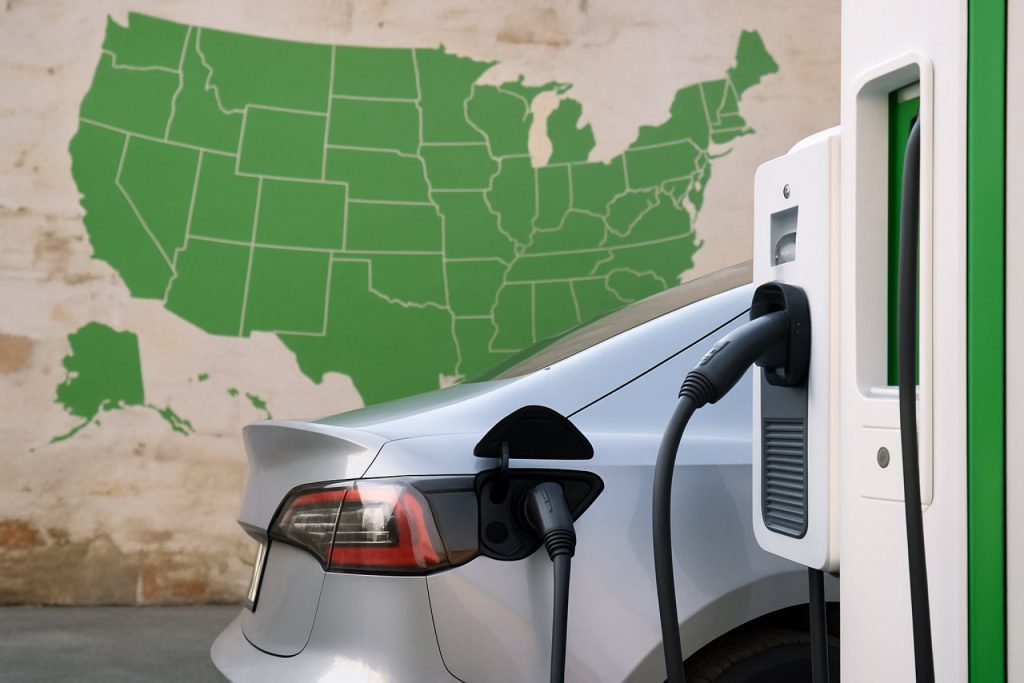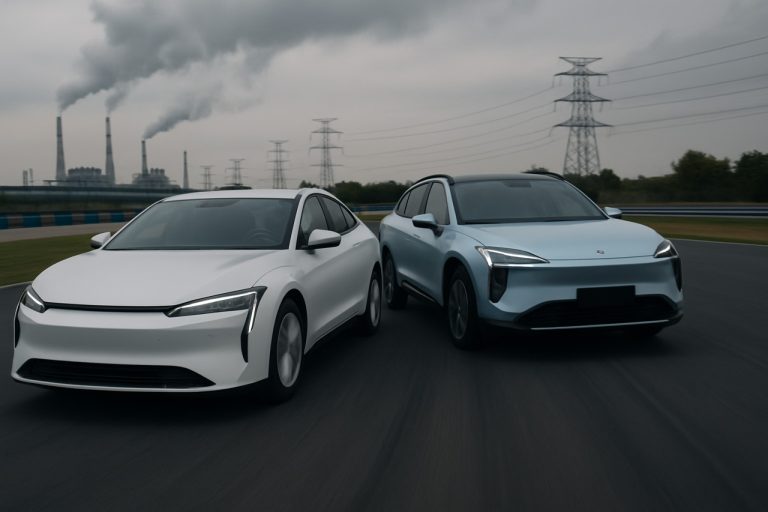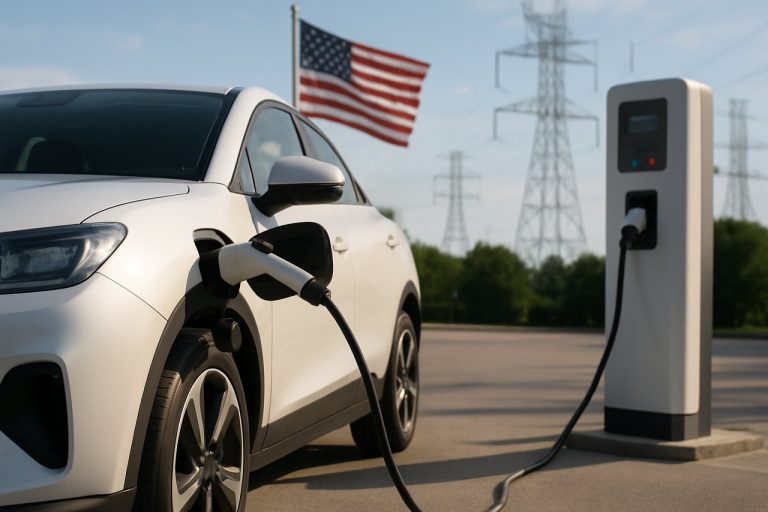
- Electric vehicle (EV) charging infrastructure in the U.S. varies widely by state, impacting convenience and adoption rates.
- Over 192,000 public charging ports exist nationwide, but the pace of growth trails behind EV ownership and government targets.
- The White House aims for 500,000 public chargers by 2026, while experts project up to two million will be needed by 2030.
- Top-performing states like Delaware, DC, and Massachusetts lead in charger density, incentives, and accessibility, supporting rapid EV adoption.
- EV deserts remain in places like Alaska, Arkansas, and the Midwest, where charger availability and state incentives are low.
- Strong infrastructure investments and strategic incentives are key to closing these regional gaps and ensuring equitable EV access nationwide.
Electric cars glide soundlessly along American highways, but the journey to convenient charging remains distinctly uneven across state lines. Stroll the streets of Wilmington, Delaware, and you’ll spot gleaming chargers dotting parking lots, inviting EV drivers to plug in with ease. Contrast that with Alaskan highways, where vast stretches offer only rare opportunities for a recharge—forcing drivers to plan every mile.
America’s electric revolution is gaining momentum. More than 192,000 public charging ports now punctuate the national landscape, with an additional thousand appearing each week. Yet, while this progress sparks hope, it falls short of the Department of Transportation’s ambitions—and the White House’s vision of 500,000 chargers by 2026 looms large and increasingly distant.
The reality is revealing. Today’s growth, though impressive, does not match the rapid acceleration of EV ownership or the government’s bold targets. According to projections from the National Renewable Energy Laboratory, as many as two million public chargers will be required by 2030, serving not just luxury electric cars but increasingly affordable models rolling off international assembly lines.
A closer look exposes sharp divides. Delaware stands atop innovative rankings, outclassing even California, a state often hailed as the world’s electric vehicle paradise. Washington, DC, Massachusetts, and Nevada also command top positions, thanks to potent combinations of high-powered chargers, smart geographic distribution, robust market share, and generous state incentives.
Visualize this: In DC, drivers can tap into a 50 percent tax credit, up to $10,000, to install Level 2 chargers. New York’s 19-plus rebate programs span city boroughs and rural towns alike. And across more than half the nation, homeowners can pocket an average rebate of $534 just by wiring up their garages. States with large EV incentives and practical, widely dispersed infrastructure make life on the road easier and remove anxieties about running out of juice.
Meanwhile, the nation’s EV deserts remain parched. Alaska’s charger count languishes near the bottom, with minimal incentives and a landscape challenging for would-be EV drivers. Arkansas offers little more than a $500 reimbursement, well below the national incentive average of nearly $3,500. The story repeats in states like Idaho, Nebraska, and Mississippi, which all score low on availability, speed, and adoption.
The arms race for better charging isn’t just about numbers—it’s a question of equity, opportunity, and leadership. Those states that energize their streets with robust incentives and strong planning are accelerating toward an electrified future. Others risk slowing down a movement now too potent to ignore, especially as global players like BYD roll out wallet-friendly models set to shake up the market even more.
The takeaway for drivers and policymakers is clear: infrastructure is destiny. The states that invest boldly in public charging—and help residents electrify their homes—aren’t just supporting drivers; they’re writing the next chapter of American mobility. For the EV revolution to truly empower all Americans, strategic investments—matched with smart incentives—must bridge the growing gap between the best and the rest.
A modern, carbon-free future awaits. The question remains: will every state keep pace as EVs become the new normal on America’s roads?
“Charging Up America: Why Some States Are Winning the EV Race (And What It Means for You)”
America’s EV Charging Divide: What’s Really Happening?
Electric vehicles (EVs) promise cleaner air and quieter streets, but America’s EV infrastructure still faces stark disparities. The rapid expansion of charging networks brings hope, yet challenges threaten to slow progress toward nationwide adoption. Here are the deeper facts, expert insights, and actionable tips that go beyond the headlines—and reveal what’s next for the electric mobility movement.
1. EV Charging Infrastructure: More Than Just Outlets
Types of Chargers:
– Level 1 (120V): Standard outlets, suitable for overnight home charging. Adds ~3-5 miles of range per hour.
– Level 2 (240V): Found in public spaces and homes with upgrades. Adds ~15–30 miles of range per hour.
– DC Fast Charging: High-speed public stations that add up to 80% charge in 20–40 minutes. Essential for long-distance travel.
Charger “Deserts” & Urban/Rural Disparity:
– Urban areas, especially on the coasts, see dense charger coverage thanks to policy support and early EV adoption.
– Rural America faces “charging deserts,” with up to 80–90 miles between fast charge points in states like Montana and North Dakota (US Department of Energy).
Key Industry Players:
– Tesla stands out with its proprietary Supercharger network, now opening select chargers to non-Tesla owners.
– ChargePoint, EVgo, and Electrify America are expanding nationally, but vary widely in pricing and network reliability (Tesla).
2. How-To: EV Charging Life Hacks
Planning a Stress-Free EV Road Trip:
– Use apps like PlugShare or A Better Routeplanner to locate compatible chargers along your journey.
– Always have a backup charging location; networks can be down due to maintenance or outages.
– For non-Tesla EVs, check network compatibility (CCS vs CHAdeMO connectors).
Home Charging Tips:
– Apply for state and local rebates (some utilities offer up to $1,000 for home Level 2 installation).
– Charge during off-peak hours if possible to save on energy costs and reduce grid strain.
3. Real-World Use Cases & Industry Forecasts
Workplaces & Retail Charging:
– Many employers and malls now offer EV charging as an amenity; companies like Volta and Blink are rapidly deploying units at shopping centers.
Fleets & Delivery Services:
– Amazon, UPS, and FedEx are electrifying fleets, driving the need for urban charging hubs (source: McKinsey, 2023).
Market Outlook:
– According to BloombergNEF, U.S. EV sales may double by 2025, requiring a tenfold increase in public charging by 2030.
4. Features, Security & Sustainability
– Leading networks now offer 24/7 surveillance and credit card security to combat charger tampering.
– More chargers are powered by renewable energy, with Tesla and others installing solar canopies.
Sustainability Fact:
– According to Argonne National Laboratory, charging an EV in most U.S. states produces 60–75% lower lifetime CO2 emissions versus gasoline.
5. State-by-State Incentive Showdown
Most Generous States:
– Delaware: Outpaces even California for incentives and charger access.
– California: Offers up to $2,000 state rebates plus local incentives and access to HOV lanes.
– Massachusetts: $1,500 rebates and support through the MOR-EV program.
Least Supportive States:
– Alaska & Mississippi: Low incentives and vast stretches with little infrastructure.
– Arkansas: $500 reimbursement, far below the $3,500 national incentive average.
Interactive Tool:
Compare incentives by ZIP code using the AFDC tool on the Department of Energy site.
6. Reviews & User Complaints
– Users praise Tesla’s reliability and speed.
– Complaints for other networks include broken chargers, complex pricing, and inadequate signage.
– Apps like PlugShare allow real-time reporting and user-driven updates on charger status.
7. Controversies, Limitations & Equity Concerns
– Inner-city and rural infrastructure lags, worsening the “mobility gap.” (Source: International Council on Clean Transportation, ICCT)
– Low-income drivers often lack garages or private parking for overnight charging.
– Interoperability between networks is a work in progress.
8. Pros & Cons Overview
Pros:
– Lower fuel costs (average $0.06/mile vs $0.14/mile for gas).
– Reduced maintenance—no oil changes, fewer moving parts.
– State and federal rebates can dramatically reduce upfront costs.
Cons:
– Patchy charging infrastructure in much of the country.
– Higher upfront purchase price for many EVs (though prices are falling).
– Battery degradation and recycling logistics are still evolving.
9. Pressing Reader Questions — Answered
Can you charge an EV in freezing weather?
Yes, but charging speed can decrease by up to 30%. Precondition battery in cold regions before plugging in.
Do all chargers work for all cars?
Not always—Tesla adapters are required for most non-Teslas to use Superchargers. Most new cars support CCS, but always check compatibility.
Are charging stations safe from cyberattacks?
Major networks are improving security, but cybersecurity for connected charging (“smart charging”) remains an industry concern, per [NIST](https://www.nist.gov/).
10. Quick Tips & Actionable Recommendations
– Research your state and local EV incentives before buying an EV; many are first-come, first-served.
– Consider a Level 2 home charger for daily convenience—you may recoup the cost with rebates.
– Join EV networks for membership discounts and exclusive charging access.
– Plan longer trips ahead; rural and interstate corridors remain underdeveloped.
– Get familiar with maintenance-free EV benefits—schedule less, drive more.
Conclusion: What’s Next for EV Adoption?
States that invest in robust, strategically distributed charging infrastructure—and pair it with meaningful incentives—are writing the new, cleaner chapter of American transportation. For drivers and policymakers alike, plugging the infrastructure gap is more than a race for convenience; it’s a test of whether America can deliver a truly equitable, sustainable future.
Stay plugged in to updates, incentives, and best practices from government sources like the Department of Energy and Department of Transportation.
Act Now: If you’re considering an EV, leverage today’s incentives, explore your local charging network, and drive confidently toward a smarter, cleaner future!



